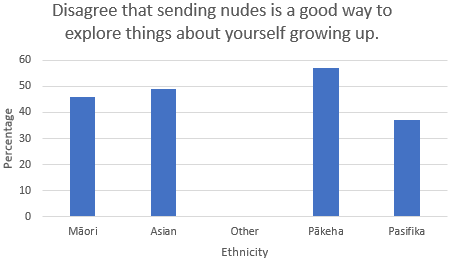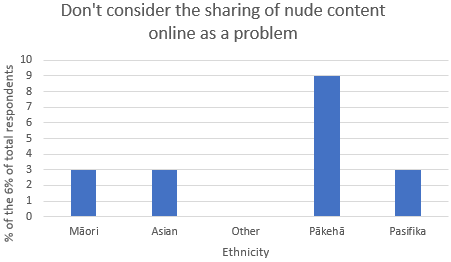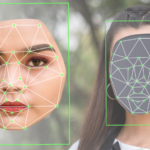In late 2017 NetSafe released a research report about New Zealand teenage sexting. NetSafe state that the report was the first time this type of research had been completed in New Zealand and that it is a snap shot that they hoped would be a springboard for more research.
This report analyzes the NetSafe research data and extracts Māori related information to better understand the current risks impacting Māori youth. The Māori related report is downloadable here or viewable online below.
This is a research report and is not a self-help resource. If you or anyone you know requires assistance, please visit NetSafe http://www.netsafe.org.nz or Ph 0508 NETSAFE (0508 638 723). If you’re in danger or a crime is being committed, call 111 immediately.
Download the complete Māori statistics report here.
Author: Karaitiana Taiuru
Date: January 2018
URL: http://www.taiuru.maori.nz
Copyright: This work is licensed under a Creative Commons Attribution 3.0 New Zealand License.
A. Summary of findings
B. Definition of sexting
C. Introduction
D. Methodology
E. Comparison of Māori teenagers to other ethnicities
E.1 Teens have received unsolicited nude or nearly nude content
E2. Teens who were asked for nude or nearly nude content of themselves
E3. Teens who agree that nudes are rarely shared
E4. Teens who agree that sometimes sharing of nudes occur
E5. Teens who agree that often sharing of nudes occur
E6. Teens who agree that very often sharing of nudes occur
E7. Disagree that sending nudes is a good way to explore things about yourself growing upE8. Don’t consider the sharing of nude content online as a problem
F. Questions quoted in the research with Māori feedback
G. Sample questions asked in the survey with no Māori feedback
H. Future considerations for a kaupapa Maori research on teens and sexting
Conclusion
References
A. Summary of findings
Māori teenagers are more likely to receive unsolicited nude or nearly nude content and to be asked for nude content of themselves than any other ethnicity.
Māori teenage girls are more likely to be targeted and requested for nude content, or targeted and sent nude content from people without request than any other ethnicity (based on all female statistics).
The report provided statistics for participants with disabilities. Analysis of the data showed that Māori girls with a disability are likely to be more vulnerable to receiving and being asked for nude content compared to girls with no disability (based on overall findings).
Māori and Pasifika teens do not think sharing nude pictures of themselves is a good way to explore themselves as they grow up, compared to 20% more of NZ European/Pākehā teens who believe it is a good way to explore themselves.
The majority of teens consider sending nude content is a problem. Of the minority who disagree and consider sending nude content is okay, NZ European/Pākehā were three times more likely than Māori, Pacific and Asian teens to disagree.
Sharing nude content is not commonly spoken about in Māori teen culture.
Of about 240 Māori participants aged between 14-17:
- Approximately 58 Māori teens have received unsolicited nude or nearly nude content.
- Approximately 65 Māori teens were asked for nude or nearly nude content of themselves.
- 110 Māori participants disagree with the following statement “Sending nudes is a good way to explore things about themselves as they grow up”.
- 36 Māori participants agree that rarely does sharing of nudes occur.
- 67 Māori participants agree that sometimes sharing of nudes occur.
- 91 Māori participants agree that nudes are often shared.
- 48 Māori participants agree that is very often that sharing of nudes occur.
- 110 Māori participants agree that sending nudes is a good way to explore things about yourself growing up.
- Approximately 2 Māori participants do not consider the sharing of nude content online as a problem.
B. Definition of sexting
The broadly accepted definition of sexting sending, receiving, or forwarding sexually explicit messages, photographs or images, primarily between mobile phones. It may also include the use of a computer or any digital device, Salter, Michael. (2013).
C. Introduction
In late 2017 NetSafe released a research report about New Zealand teenage sexting. NetSafe (2017) state that the report was the first time this type of research had been completed in New Zealand and that it is a snap shot that they hoped would be a springboard for more research. This report analyzes the NetSafe research data and extracts Māori related information to better understand the current risks impacting Māori youth.
The results have identified the need for Māori specific research using kaupapa Māori research methodologies (Smith, 1999). This type of approach will better enable researchers to design, survey, collect and analyse data that is Māori youth specific. This report also identifies trends that directly show how Māori are affected by sexting.
The results did not differentiate Māori by gender, knowledge of te ao Māori or disability. Mixed ethnicities were not included in the report which created a challenge to clearly identify some statistics. In these cases, where a conclusion is obvious by extrapolation, this is noted.
This is a research report and is not a self-help resource. If you or anyone you know requires assistance, please visit NetSafe http://www.netsafe.org.nz or Ph 0508 NETSAFE (0508 638 723). If you’re in danger or a crime is being committed, call 111 immediately.
D. Methodology
This report analyses and extracts data from the NetSafe survey retrieved from https://www.netsafe.org.nz/teens-sexting-report/ retrieved December 2017. The objective was to gain an understanding of the prevalence and extent of sharing of nudes among teens aged 14-17 years old.
The analyzed survey:
• Was limited to 1001 participants of which about 240 (24%), participants self identified as Māori.
• The other participants consisted of 660 NZ/Pākeha (66%) , 130 Pacifica (13%), (13%), Asian, 40 (4%) participants identified themselves as being “other ethnicity”.
• Was conducted with an online survey tool over a 5 week period with 1,001 14-17 year old New Zealand teens.
• Questions related to activity over the past 12 months.
• The survey has an error of margin of 3.1%.
This report is independent of any third party including the author and publisher of the original survey.
E. Comparison of Māori teenagers to other ethnicities
E.1 Teens have received unsolicited nude or nearly nude content
24% of Māori teens have received unsolicited nude or nearly nude content, compared to NZ European/Pākehā and Pacific 18%.

E2. Teens who were asked for nude or nearly nude content of themselves
27% of Māori teens were asked for nude or nearly nude content of themselves, compared to 24% of Pacific and 21% of NZ European/Pākehā participants.

E3. Teens who agree that nudes are rarely shared
15% of Māori agree that nudes are rarely shared compared to 19% Pacific, 12% NZ European/Pākehā, 16% Asian and 8% of other nationalities who were surveyed.

E4. Teens who agree that sometimes sharing of nudes occur
28% of Māori agree that sometimes sharing of nudes occurs compared to 18% Pacific, 37% NZ European/Pākehā, 46% Asian and 36% of other nationalities who were surveyed.

E5. Teens who agree that often sharing of nudes occur

E6. Teens who agree that very often sharing of nudes occur
20% of Māori agree that very often sharing of nudes occur compared to 14% of Pacific, 12% NZ European/Pākehā, Asian 17% and 20% of other nationalities who were surveyed.

E7. Disagree that sending nudes is a good way to explore things about yourself growing up
46% of Māori, 57% of NZ European/Pākehā, 49% of Asian, and 37% Pasifika expressed their disagreement to the following statement “Sending nudes is a good way to explore things about yourself growing up.”

E8. Don’t consider the sharing of nude content online as a problem
Of a total of 6% of participants who responded, 3% of Māori do not consider the sharing of nude content online as a problem compared to 9% of NZ European/Pākehā, 3% Pacific and 3% Asian participates.

F. Questions quoted in the research with Māori feedback
- Participants mentioned social pressure as a significant factor that explains the sharing of nude content online among some teens. Respondents who shared this view highlighted that pressure from peers exerted a role.
“Mostly, I think it’s all to do with peer pressure If your friends are doing it then they think you should too. I think that’s stupid.” Female, 17 years, Māori - Some comments put the sharing of nudes in the context of teens seeking to develop and maintain romantic relationships but also as a mechanism to forge trust with their partners.
“It’s usually because they like the boy/girl who asked for the nude pics and they’ll do whatever he/she says just to make him/her like them or ask them out. That’s what happens with girls at my school, don’t know if it’s the same elsewhere.” Female, 14 years, Māori.
G. Sample questions asked in the survey with no Māori feedback
- Moral Stance about the behavior, page 28.
17% of participants hold a moral stance against teens who send nudes of themselves. There were 4 NZ/European comments and one Asian comment. - Sexual Exploration/Relationships page 29
15% of comments fitted into the sexual exploration/relationships category. These views were more common among teens with an Asian background (22%), followed by those participants identifying as NZ European/Pākehā (17%).
H. Future considerations for a kaupapa Maori research on teens and sexting
- Any future survey on prevalence and attitudes of Māori teenagers sexting, should consider that there are generations of Māori who are native Maori language speakers, having been educated at Kōhanga Reo and Kura Kaupapa. Their belief systems are different and their exposure outside of their Māori environments is different than a child who is not brought up in the same environment.
- Consideration to offering the survey in te reo Māori.
- Māori who are comfortable with and have a strong affiliation to the marae, whanau and Iwi are likely to have different values, Statistics New Zealand. (2014).
- The current survey results did not differentiate between ethnicity of genders. This break down would show if Māori teenage boys or girls are at more risk and where the risks are.
- The current survey does not consider that New Zealand has a long history of mixed ethnicity relationships that is well documented from the first arrival of the Europeans[1].
- For some Māori, identifying only as Māori is not acceptable. They would prefer to identify only as Māori/European or Māori/Samoan etc. Participants who did not identify only as European/Māori/Pacific/Asian were categorized as “Other ethnicity”.
- 150 teens with a disability were not further classified into an ethnicity category. Based on the report, there is no statistical evidence provided about Māori teens with a disability. This report has extrapolated that the percentages of Māori participants who are disabled reflects that overall Māori participants.
- Considerations for communal computers at marae and other whānau and Iwi locations has not been discussed in the report.
- Māori sometimes choose to not comply with the ethnicity question of research due to a long established practice of only negative statistics being used.
- 10. Social issues with trust of social and government agencies has not been considered (Winiata & Fraenkel, 1967).
- Despite the fact that an on-screen warning message recommended respondents to complete the questions on their own while no-one else was watching the screen, about 300 participants completed the online survey with a parent/caregiver close to them. This could skew results for any participant.
- The on screen warning may not deter other whānau from sitting in front of the screen.
- Considerations of Māori behavior with technology research commissioned by Te Puni Kōkiri (Kōkiri, 2007) , (NZ, 2009a), (NZ, 2009b), (Kōkiri, 2010), (Sciascia, 2017) and (Clark, 2001) et al need consideration.
[1] https://teara.govt.nz/en/intermarriage/page-1
Conclusion
Māori teenagers are more likely to receive unsolicited naked pictures and to be asked for naked pictures at a higher rate than any other ethnicity, despite many Māori teenagers believing that sexting is not a good idea.
The overall statistics suggest that Māori female teenagers with a disability are at a higher risk than other ethnicities of unwanted sexting and sexting requests.
There is a need for more safety resources and education for Māori teenagers. Also the need for the creation of kaupapa Māori safety resources that are applicable to Māori children of all ages, also to those who are raised in a kaupapa Māori environment such as Kōhanga, Kura Kaupapa and marae communities.
In addition to the need for new resources, specifically targeted Māori teenager sexting research that uses indigenous research methodologies would provide more accurate statistical data of the risks and how to combat them in order to protect Māori teenagers.
References
Clark, V. N. (2001). Cultural Influences in contribution to electronic group communication discussions. He
PuKenga Korero, 6(2).
Kōkiri, T. P. (2007). Te Ao Pāpaho Māori Māori Broadcasting and e-Media. Te Puni Kōkiri.
Kōkiri, T. P. (2010). Use of Broadcasting and e-Media, Māori language and culture. Te Puni Kōkiri.
Netsafe. (2017). Teens and “sexting” in New Zealand: Prevalence and attitudes. Wellington, NZ: Netsafe.
NZ, Research. (2009a). Current and future broadcasting and e-media preferences of Māori youth Qualitative
research report.
NZ, Research. (2009b). New Zealanders’ Use of Broadcasting and Related Media FINAL Report.
Sciascia, A. D. (2017). Māori cultural revitalisation in social networking sites. Te Puni Kōkiri.
Smith, L. T. (1999). Decolonizing methodologies: research and indigenous peoples. Dunedin, N.Z;London;
Zed Books.
Salter, Michael (2013). “Beyond Criminalisation and Responsibilitisim Sexting, Gender and Young People”. Sydney Law School. 24: 310–315.
Statistics New Zealand. (2014). Taku marae e: Connecting to ancestral marae 2013. Retrieved from
http://www.stats.govt.nz/Census/2013-census/profile-and-summary-reports/iwi-profiles-individual.aspx?request_value=24632&tabname=Populationandgeography
Winiata, M., & Fraenkel, M. (1967). The changing role of the leader in Maori society: A study in social
change and race relations. Auckland, New Zealand: Blackwood and Janet Paul.






Leave a Reply